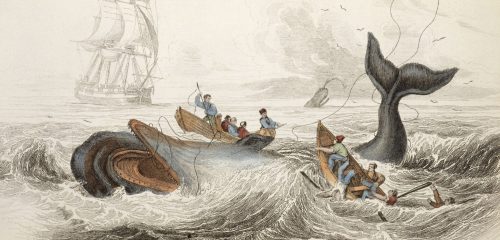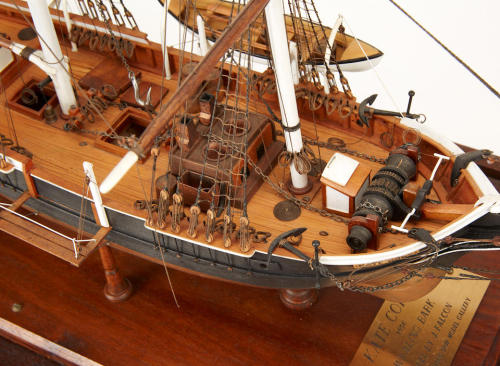Processing of a Whale in the 19th century
- Please read beforehand, the following post describes the processing of a whale on board a whaler in the 19th century. If you have a problem with this, I would strongly warn you not to read it. Due to the subject matter, I have also refrained from using precise pictures. I would also like to point out that I am not a friend of whaling, which is absolutely unnecessary today, and what happened in the past cannot be undone. I am only interested in explaining the work on a whale and making it understandable. -

Once the whaling crew successfully slew a whale, were the men rewarded with a change of dry clothes, something to eat, and a warm bed ? Hardly. Their work had just begun. No matter how late the hour or how tired the crew, the whale had to be cut up and boiled before the sharks got to it. A whaler crew cutting and boiling a whale at sea was startling sight, often compared to the infernos of hell. Thick clouds of black smoke furled through the ship’s masts, dipped the sails in a rich black. Blood, oil and blubber sloshed over its deck. Crews of merchant ships often saif that they could smell a whaler before they saw it. The odor was awful.

Whalers cutting the Whale, 1878 (x)
The first step processing the whale was called cutting in. The crew towed the enormous carcass back to the ship, to which it was attached with chains. A narrow platform was hoisted above the whale, where the mates perched while they cut into it with 6,10 m long blades.
If the catch were a sperm whale, the head was cut off and divided into three parts: the case ( forehead), the junk( lower half of the forehead), and the jaw. The case held the valuable oil known as spermaceti, this hardened into a white, waxy substance that the men bailed out in buckets. If the case were too heavy to be lifted into the ship, a man would jump into the head and bail the oil from there. The junk held oil that was less pure but still valuable, the jaw yielded teeth. Right, bowhead and gray whales jaws were harvested for their baleen.

A Whaler in the 19th century (x)
The fat, or blubber, of a whale was stripped from around the whale in a process that was something like peeling an orange. It was cut into one to two ton strips called blanket pieces that were pulled over the side with giant hooks. These slabs were lowered below deck into the blubber room, where they were cut into blocks called horse piecesm, and then into smaller pieces that looked like the pages of a book, called bilbe leaves. the carcass was then tossed back to the sea where ravenous sharks and birds soon devoured it.

The stove area aboard a whaler here to see i nthe model of the Whaler Kate Cory of 1856, by J. Falcon 20th century (x)
The second stage of whale processing was called trying out. The bilbe leaves were fed into enormous pots oer a brick stove on deck, called a tryworks, where they were boiled for an hour or more and turned into oil. A constant fire, fed first by wood and then by scraps of blubber skimmed from the top of the pots, spewed black, nauseating smoke for miles. A 30cm case filled with seawater, called the goose pen, was placed between the hot fire and the wooden deck to prevent the deck from catching on fire. This stage went on for hours until finally all the blubber had been boiled down. Then the oil was colled and stored in barrels in the hold of the ship. The average whale yielded about 24 to 40 barrels of oil.
During this process the deck and crew were awash in gurry - a mix of blood, seawater, and oil. Everything was covered with soot and ash from the trypots. The men’s clothes, beds, and even their food reeked of the boiling blubber. The men worked in 6- hour watches aroung the clock until their task was accomplished. Unpleasant as it might seem, this was the business of the whaler, and what everyone worked to achieve. they knew that when the ship’s hold was filled with oil, they could go home. The success of voyage was appropriately called greasy luck.
143 notes
 herfirstandonlydaddy reblogged this from stageyeswideshut and added:
herfirstandonlydaddy reblogged this from stageyeswideshut and added:Quite informative.
 herfirstandonlydaddy said: Quite informative - despite how far society and the industry has come from the dark past.
herfirstandonlydaddy said: Quite informative - despite how far society and the industry has come from the dark past. herfirstandonlydaddy liked this
herfirstandonlydaddy liked this prompts-for-every-need liked this
prompts-for-every-need liked this kwhi186 liked this
kwhi186 liked this poppakilo liked this
poppakilo liked thiswhatimidoingwithmylifehelp reblogged this from ltwilliammowett
whatimidoingwithmylifehelp liked this
 makdeth liked this
makdeth liked this captainsvessel reblogged this from ltwilliammowett
captainsvessel reblogged this from ltwilliammowett captainsvessel liked this
captainsvessel liked this happi90 liked this
happi90 liked this swingindoorsusan liked this
swingindoorsusan liked this acidyellowlava liked this
acidyellowlava liked thisicecreamregrets liked this
 john62 liked this
john62 liked this berkinix liked this
berkinix liked thisconsistantly-changing reblogged this from ltwilliammowett
quinticprisms liked this
nopostradio reblogged this from idle-drifter
 ashbury41 liked this
ashbury41 liked thiswrite-on-world reblogged this from ltwilliammowett and added:
I always used to wonder what happened between whales in Moby Dick.
write-on-world liked this
 stageyeswideshut liked this
stageyeswideshut liked thissub-urbanwitch liked this
 beshruth liked this
beshruth liked this delhud412six liked this
delhud412six liked thiskivulimi reblogged this from ltwilliammowett
kivulimi liked this
 carolus666 liked this
carolus666 liked this76historylover liked this
jackalyote liked this
 lekesan reblogged this from ltwilliammowett
lekesan reblogged this from ltwilliammowettidkaboutnames reblogged this from ltwilliammowett
idkaboutnames liked this
ltwilliammowett posted this
- Show more notes
